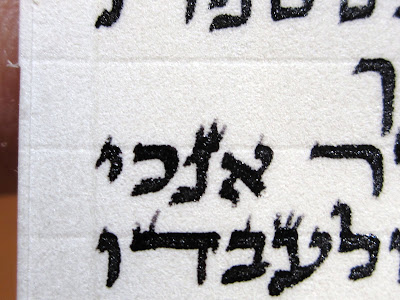Nun and Zaiyin

 The head of the nun is unbalanced, should it be fixed with hosafas dio on the bottom right part of it or shav vial taseh adif? (maybe it would make it too wide?)
The head of the nun is unbalanced, should it be fixed with hosafas dio on the bottom right part of it or shav vial taseh adif? (maybe it would make it too wide?)The Nun in the second picture is moiel havchanos tinok?
In this third picture is the second zayin of Mezuzas moiel havchanos tinok, (Some say that 3 and a half kolmosim is a kosher nun sofit at least bidieved).


The word anochi, is kosher as it is. The metayeg (as usual) made a mess. If you want to add dyo to the right it is ok. [better - if you would have time - to scrape away that whole top [above the original rosh] and reshape the rosh and tagim.
ReplyDeleteThe venasati is a shaylas tinok and should be fixed (by adding to the right of the neck, and slope it, so it will look more as a nun).
The zayin is definitly a shylas tinok (show the tinok several zayins and nun pshuta, then cover the vov tov of the word and ask.
BTW the yud of beisecha is quite long, should be fixed by adding a strip of dyo from the kotz RT toward the right, and then a new kotz RT.